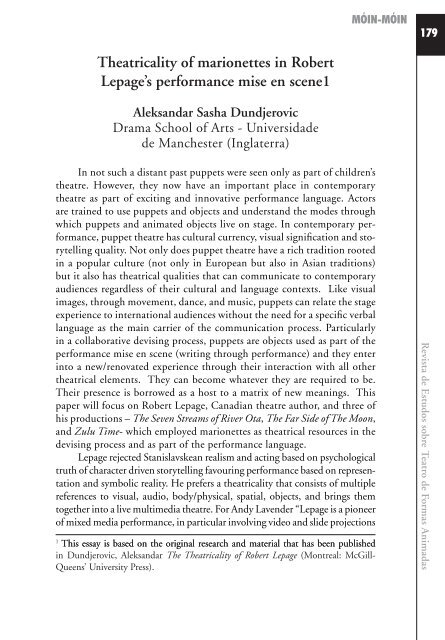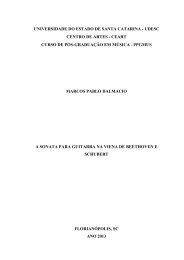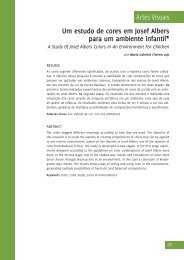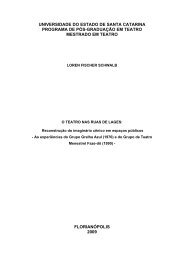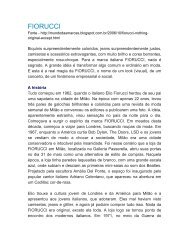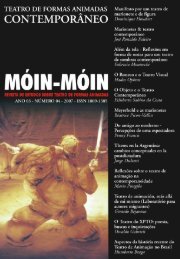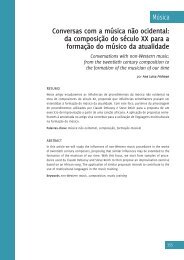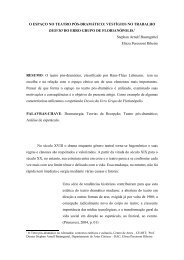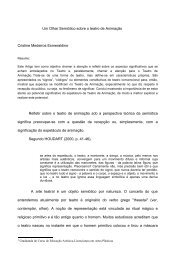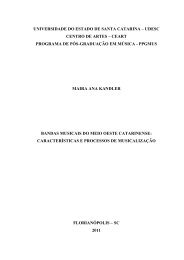Edição e distribuição www.designeditora.com.br Tipologia Adobe ...
Edição e distribuição www.designeditora.com.br Tipologia Adobe ...
Edição e distribuição www.designeditora.com.br Tipologia Adobe ...
You also want an ePaper? Increase the reach of your titles
YUMPU automatically turns print PDFs into web optimized ePapers that Google loves.
Theatricality of marionettes in Robert<<strong>br</strong> />
Lepage’s performance mise en scene1<<strong>br</strong> />
Aleksandar Sasha Dundjerovic<<strong>br</strong> />
Drama School of Arts - Universidade<<strong>br</strong> />
de Manchester (Inglaterra)<<strong>br</strong> />
In not such a distant past puppets were seen only as part of children’s<<strong>br</strong> />
theatre. However, they now have an important place in contemporary<<strong>br</strong> />
theatre as part of exciting and innovative performance language. Actors<<strong>br</strong> />
are trained to use puppets and objects and understand the modes through<<strong>br</strong> />
which puppets and animated objects live on stage. In contemporary performance,<<strong>br</strong> />
puppet theatre has cultural currency, visual signification and storytelling<<strong>br</strong> />
quality. Not only does puppet theatre have a rich tradition rooted<<strong>br</strong> />
in a popular culture (not only in European but also in Asian traditions)<<strong>br</strong> />
but it also has theatrical qualities that can <strong>com</strong>municate to contemporary<<strong>br</strong> />
audiences regardless of their cultural and language contexts. Like visual<<strong>br</strong> />
images, through movement, dance, and music, puppets can relate the stage<<strong>br</strong> />
experience to international audiences without the need for a specific verbal<<strong>br</strong> />
language as the main carrier of the <strong>com</strong>munication process. Particularly<<strong>br</strong> />
in a collaborative devising process, puppets are objects used as part of the<<strong>br</strong> />
performance mise en scene (writing through performance) and they enter<<strong>br</strong> />
into a new/renovated experience through their interaction with all other<<strong>br</strong> />
theatrical elements. They can be<strong>com</strong>e whatever they are required to be.<<strong>br</strong> />
Their presence is borrowed as a host to a matrix of new meanings. This<<strong>br</strong> />
paper will focus on Robert Lepage, Canadian theatre author, and three of<<strong>br</strong> />
his productions – The Seven Streams of River Ota, The Far Side of The Moon,<<strong>br</strong> />
and Zulu Time- which employed marionettes as theatrical resources in the<<strong>br</strong> />
devising process and as part of the performance language.<<strong>br</strong> />
Lepage rejected Stanislavskean realism and acting based on psychological<<strong>br</strong> />
truth of character driven storytelling favouring performance based on representation<<strong>br</strong> />
and symbolic reality. He prefers a theatricality that consists of multiple<<strong>br</strong> />
references to visual, audio, body/physical, spatial, objects, and <strong>br</strong>ings them<<strong>br</strong> />
together into a live multimedia theatre. For Andy Lavender “Lepage is a pioneer<<strong>br</strong> />
of mixed media performance, in particular involving video and slide projections<<strong>br</strong> />
1 This essay is based on the original research and material that has been published<<strong>br</strong> />
This essay is based on the original research and material that has been published<<strong>br</strong> />
in Dundjerovic, Aleksandar The Theatricality of Robert Lepage (Montreal: McGill-<<strong>br</strong> />
Queens’ University Press).<<strong>br</strong> />
MÓIN-MÓIN<<strong>br</strong> />
179<<strong>br</strong> />
Revista de Estudos so<strong>br</strong>e Teatro de Formas Animadas


